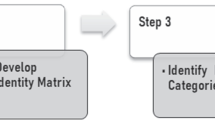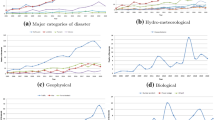Abstract
The frequency of the occurrence of disasters, and the severity of their effects have both been significantly rising over the past few decades across the world. Recognizing the potential of Artificial Intelligence (AI), particularly its subset, Machine Learning (ML), this study delves into its application in disaster management. More specifically, this study adopted the bibliometric analysis methodology to examine the most active authors, countries, and institutions in research related to the use of ML in disaster management and to investigate the trending themes associated with ML use in disaster management. Based on the results, it can be concluded that the citation networks demonstrate the close collaboration between the USA, India, China, and Australia. India had the most articles cited with 1672 citations, despite China having the largest production of research related to the use of ML in disaster management. Furthermore, besides “disaster management” and “machine learning” which were expected to be part of the key drivers in this research area, “remote sensing” also emerged as a trending topic. Based on the thematic analysis of the various articles retrieved in this study, future research must include fourth industrial revolution (4IR) technologies, as they are crucial to disaster management.
Access this chapter
Tax calculation will be finalised at checkout
Purchases are for personal use only
Similar content being viewed by others
References
Kankanamge, N., Yigitcanlar, T., Goonetilleke, A.: Public perceptions on artificial intelligence driven disaster management: evidence from Sydney, Melbourne and Brisbane. Telemat. Inform. 65, 101729 (2021). https://doi.org/10.1016/j.tele.2021.101729
Munawar, H.S., Mojtahedi, M., Hammad, A.W.A., Kouzani, A., Mahmud, M.A.P.: Disruptive technologies as a solution for disaster risk management: a review. Sci. Total Environ. 806 (2022). https://doi.org/10.1016/j.scitotenv.2021.151351
Prasad, R., Udeme, A.U., Misra, S., Bisallah, H.: Identification and classification of transportation disaster tweets using improved bidirectional encoder representations from transformers. Int. J. Inf. Manag. Data Insights 3(1), 1–8 (2023). https://doi.org/10.1016/j.jjimei.2023.100154
Powers, C.J., et al.: Using artificial intelligence to identify emergency messages on social media during a natural disaster: a deep learning approach. Int. J. Inf. Manag. Data Insights 3(1), 100164 (2023). https://doi.org/10.1016/j.jjimei.2023.100164
Farazmehr, S., Wu, Y.: Locating and deploying essential goods and equipment in disasters using AI-enabled approaches: a systematic literature review. Prog. Disaster Sci. 19, 100292 (2023). https://doi.org/10.1016/j.pdisas.2023.100292
Chen, Y.J., et al.: Vulnerability-based regionalization for disaster management considering storms and earthquakes. Transp. Res. Part E Logist. Transp. Rev. 169, 102987 (2023). https://doi.org/10.1016/j.tre.2022.102987
Enns, C., Bersaglio, B., Karmushu, R.: Disaster management takes to the skies: how new technologies are reconfiguring spatialities of power in desert locust management. Polit. Geogr. 98, 102732 (2022). https://doi.org/10.1016/j.polgeo.2022.102732
Munawar, H.S., Hammad, A.W.A., Waller, S.T.: A review on flood management technologies related to image processing and machine learning. Autom. Constr. 132, 103916 (2021). https://doi.org/10.1016/j.autcon.2021.103916
Habibi, A., Delavar, M.R., Sadeghian, M.S., Nazari, B., Pirasteh, S.: A hybrid of ensemble machine learning models with RFE and Boruta wrapper-based algorithms for flash flood susceptibility assessment. Int. J. Appl. Earth Obs. Geoinf. 122, 103401 (2023). https://doi.org/10.1016/j.jag.2023.103401
Donthu, N., Kumar, S., Mukherjee, D., Pandey, N., Lim, W.M.: How to conduct a bibliometric analysis: an overview and guidelines. J. Bus. Res. 133, 285–296 (2021). https://doi.org/10.1016/j.jbusres.2021.04.070
Uğur, N.G., Akbıyık, A.: Emerging trends in IS research: a co-word analysis (2007–16)/Tendances émergentes en recherche en systèmes d’information: une analyse de cooccurrents (2007–16). Can. J. Inf. Libr. Sci. 42, 228–248 (2018). https://muse.jhu.edu/article/743054/summary
Chen, X., Chen, J., Wu, D., Xie, Y., Li, J.: Mapping the research trends by co-word analysis based on keywords from funded project. Procedia Comput. Sci. 91, 547–555 (2016). Itqm. https://doi.org/10.1016/j.procs.2016.07.140
Dervis, H.: Bibliometric analysis using bibliometrix an R package. J. Scientometr. Res. 8(3), 156–160 (2019). https://doi.org/10.5530/JSCIRES.8.3.32
Lin, T.C., Tang, K.Y., Lin, S.S., Changlai, M.L., Hsu, Y.S.: A co-word analysis of selected science education literature: identifying research trends of scaffolding in two decades (2000–2019). Front. Psychol. 13, 1–14 (2022). https://doi.org/10.3389/fpsyg.2022.844425
Iqbal, U., Perez, P., Barthelemy, J.: A process-driven and need-oriented framework for review of technological contributions to disaster management. Heliyon 7(11), e08405 (2021). https://doi.org/10.1016/j.heliyon.2021.e08405
Berawi, M.A., et al.: Increasing disaster victim survival rate: SaveMyLife mobile application development. Int. J. Disaster Risk Reduct. 60 (2021). https://doi.org/10.1016/j.ijdrr.2021.102290
Guha, S., Jana, R.K., Sanyal, M.K.: Artificial neural network approaches for disaster management: a literature review. Int. J. Disaster Risk Reduct. 81, 103276 (2022). https://doi.org/10.1016/j.ijdrr.2022.103276
Vahdani, B.: A flexible framework to coordinate debris clearance and relief distribution operations: a robust machine learning approach. Expert Syst. Appl. 229(PA), 120512 (2023). https://doi.org/10.1016/j.eswa.2023.120512
Achu, A.L., et al.: Machine-learning based landslide susceptibility modeling with emphasis on uncertainty analysis. Geosci. Front. 14(6), 101657 (2023). https://doi.org/10.1016/j.gsf.2023.101657
Chikaraishi, M., et al.: On the possibility of short-term traffic prediction during disaster with machine learning approaches: an exploratory analysis. Transp. Policy 98, 91–104 (2020). https://doi.org/10.1016/j.tranpol.2020.05.023
Zhang, S., et al.: Estimating the grade of storm surge disaster loss in coastal areas of China via machine learning algorithms. Ecol. Indic. 136, 108533 (2022). https://doi.org/10.1016/j.ecolind.2022.108533
Saleem, F., Khattak, A., Ur Rehman, S., Ashiq, M.: Bibliometric analysis of green marketing research from 1977 to 2020. Publications 9(1), 1–19 (2021). https://doi.org/10.3390/publications9010001
Luo, X., Wu, Y., Niu, L., Huang, L.: Bibliometric analysis of health technology research: 1990~2020. Int. J. Environ. Res. Public Health 19(15) (2022). https://doi.org/10.3390/ijerph19159044
Wang, C., Si, L.: A bibliometric analysis of digital literacy research from 1990 to 2022 and research on emerging themes during the COVID-19 pandemic. Sustainability 15(7) (2023).https://doi.org/10.3390/su15075769
Chamola, V., Hassija, V., Gupta, V., Guizani, M.: A comprehensive review of the COVID-19 pandemic and the role of IoT, drones, AI, blockchain, and 5G in managing its impact. IEEE Access, 90225–90265 (2020)
Muhammad, K., Ahmad, J., Baik, S.W.: Early fire detection using convolutional neural networks during surveillance for effective disaster management. Neurocomputing 288, 30–42 (2018). https://doi.org/10.1016/j.neucom.2017.04.083
Agbo, F.J., Oyelere, S.S., Suhonen, J., Tukiainen, M.: Scientific production and thematic breakthroughs in smart learning environments: a bibliometric analysis. Smart Learn. Environ. 8(1), 1–25 (2021)
Fosso Wamba, S., Bawack, R.E., Guthrie, C., Queiroz, M.M., Carillo, K.D.A.: Are we preparing for a good AI society? A bibliometric review and research agenda. Technol. Forecast. Soc. Change 164 (2021). https://doi.org/10.1016/j.techfore.2020.120482
Wang, X., Lu, J., Song, Z., Zhou, Y.: From past to future: bibliometric analysis of global research productivity on nomogram (2000–2021). Front. Public Health 10, 1–15 (2022). https://doi.org/10.3389/fpubh.2022.997713
Shen, G., Zhou, L., Xue, X., Zhou, Y.: The risk impacts of global natural and technological disasters. Socioecon. Plann. Sci. 88, 1–16 (2023). https://doi.org/10.1016/j.seps.2023.101653
Rasool, U., et al.: Rainfall-driven machine learning models for accurate flood inundation mapping in Karachi, Pakistan. Urban Clim. 49, 101573 (2023). https://doi.org/10.1016/j.uclim.2023.101573
Vishwanath, T., Shirwaikar, R.D., Jaiswal, W.M., Yashaswini, M.: Social media data extraction for disaster management aid using deep learning techniques. Remote Sens. Appl. Soc. Environ. 30, 100961 (2023). https://doi.org/10.1016/j.rsase.2023.100961
Du, X., et al.: High-accuracy estimation method of typhoon storm surge disaster loss under small sample conditions by information diffusion model coupled with machine learning models. Int. J. Disaster Risk Reduct. 82, 103307 (2022). https://doi.org/10.1016/j.ijdrr.2022.103307
Shahabi, H., et al.: Flood detection and susceptibility mapping using sentinel-1 remote sensing data and a machine learning approach: hybrid intelligence of bagging ensemble based on K-Nearest Neighbor classifier. Remote Sens. 12(2), 1–30 (2020)
Zhou, X., et al.: Zonation of landslide susceptibility in Ruijin, Jiangxi, China. Int. J. Environ. Res. Public Health 18(11) (2021). https://doi.org/10.3390/ijerph18115906
Razavi-Termeh, S.V., Sadeghi-Niaraki, A., Seo, M.B., Choi, S.M.: Application of genetic algorithm in optimization parallel ensemble-based machine learning algorithms to flood susceptibility mapping using radar satellite imagery. Sci. Total Environ. 873, 162285 (2023). https://doi.org/10.1016/j.scitotenv.2023.162285
Author information
Authors and Affiliations
Corresponding author
Editor information
Editors and Affiliations
Rights and permissions
Copyright information
© 2024 IFIP International Federation for Information Processing
About this paper
Cite this paper
Maguraushe, K., Ndayizigamiye, P., Bokaba, T. (2024). Trends and Developments in the Use of Machine Learning for Disaster Management: A Bibliometric Analysis. In: Sharma, S.K., Dwivedi, Y.K., Metri, B., Lal, B., Elbanna, A. (eds) Transfer, Diffusion and Adoption of Next-Generation Digital Technologies. TDIT 2023. IFIP Advances in Information and Communication Technology, vol 698. Springer, Cham. https://doi.org/10.1007/978-3-031-50192-0_9
Download citation
DOI: https://doi.org/10.1007/978-3-031-50192-0_9
Published:
Publisher Name: Springer, Cham
Print ISBN: 978-3-031-50191-3
Online ISBN: 978-3-031-50192-0
eBook Packages: Computer ScienceComputer Science (R0)





